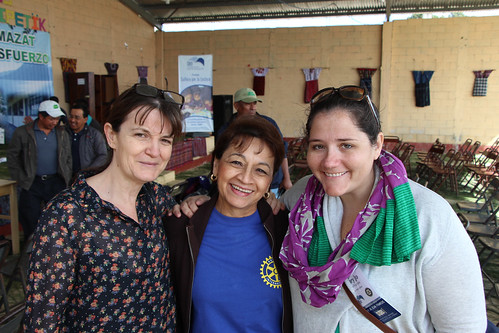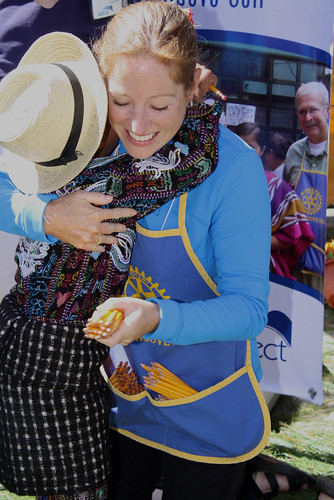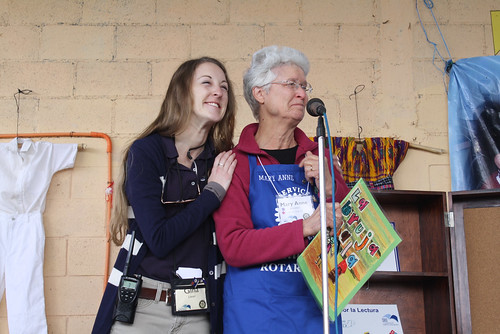Ever wondered what this Guatemala Literacy Project (GLP) thing is? We mention it every now and again – and it plays an important role in the work of CoEd in Guatemala. So what is it? Since 1998, Cooperative for Education has been proud to work with individual Rotary International clubs (432 of them to be exact) to bring books, computers, training, and other resources to the poorest in Guatemala. Each year a large group of Rotarians help the programs come into new communities in Guatemala.
Since March is Literacy Month for Rotary we wanted to take a moment to interview Mary Jo Jean-Francois, Rotary International’s (RI) Area Focus Manager in Basic Education & Literacy. In February we were pleased to have Mary Jo join us in Guatemala to see the work being done. Here’s what Mary Jo had to say to us after her recent trip to see the GLP in action.

Mary Jo (right) spent time visiting the GLP in February. Pictured here with Rotarians from Guatemala City.
Why has Rotary International designated March as Literacy Month?
Rotarians around the world do thousands of literacy projects each year. Some projects are funded by The Rotary Foundation, but the majority are not. The Board of Directors for Rotary International wanted to highlight this work, recognize Rotarians for the endless volunteer hours they put toward their projects and to encourage clubs and districts to continue on with such an important initiative. Having one month dedicated to literacy allows the organization to collectively promote efforts supporting education.

How does the Guatemala Literacy Project differ from other international literacy projects you’ve visited in the past?
One of the best parts of my position at RI is to visit projects Rotarians are doing. Even when I’m unable to visit a project, I always hear from Rotarians about the projects they are working on and often get to see photos and videos. Every project is unique and this is because every project is sponsored by different clubs and districts with their own exciting visions working with communities with distinct needs and strengths. GLP is the only project I’ve visited where the international sponsors travel down in such a large group to visit the sites where the project is being implemented. It creates a lot of excitement, both for the Rotarians and for the local communities, and I think that it really embodies the vision of Rotary founder, Paul Harris, to create fellowship among people by doing good works. The excitement of the Rotarians involved with the GLP is contagious and it is not surprising that each year more clubs sign on to sponsor these literacy grants.
The other unique aspect of the GLP is that I believe it could be replicated in other grants. The revolving fund concept is not something we see in grant projects of which I’m aware, but the donation of books and teacher training is something that is very important to Rotarians based on other projects that I have seen.
What does the future hold within Rotary International for Rotary clubs working with cooperating organizations like CoEd? What is necessary to have collaboration between Rotary clubs and non-profits?
I think there is a lot of opportunity for Rotarians to collaborate with cooperating organizations on a club and district level or within a global grant context. Ultimately, true collaboration is the key to effectiveness and strong project implementation. Rotarians have so much to offer when it comes to doing projects and I think that’s why it is appealing for cooperating organizations to work with us. Throughout the world, we have 1.2 million passionate Rotarians—that is a lot of manpower to do good things in the world!
However, we recognize that Rotarians are volunteers and that their time cannot be totally dedicated to a project. Also, we often rely on the expertise of cooperating organizations for assistance in trainings, monitoring and evaluation. In my mind, a great collaboration highlights the strengths of both partners, recognizes areas of each that need assistance and then works hand-in-hand to accomplish a common goal.

Mary Anne Johnston, from Summit County, CO is passionate about literacy in Guatemala it shows each time she travels to deliver resources to the schools.
What is different about Rotary’s focus in the new Global Grant process?
The new global grant process differs quite a bit from matching grants. Matching grants had lower funding requirements and could primarily focus on things like equipment. Global grants are meant to be a bit larger and more comprehensive, with a focus on sustainability. Therefore, while global grants can still purchase materials, but should focus on capacity building of a community through community assessments (understanding the community’s strengths and needs) and training that will help the community to provide solutions to their needs after Rotary grant funding has ended. Rotarians are always welcome to visit the Rotary Global Grants webpage for more information.
What would you say to a Club President or International Chair who is looking to make an impact in a developing nation?
The best advice I could give would be to identify an area where your club would like to work and then find a club in that area and build a relationship. Through that relationship, see if your club goals match with each other and then the next step is to see if those goals meet the needs of the local community. I truly believe that impact cannot be made unless it is driven by the local community. As international sponsors, our work is to walk along side communities and support them. Empowering local communities is the best way to make long-term, sustainable impact.
We couldn’t agree more with your last statement Mary Jo! Thanks for spending time with us at Bookmarks today!

